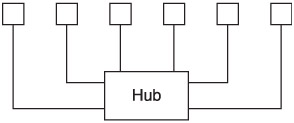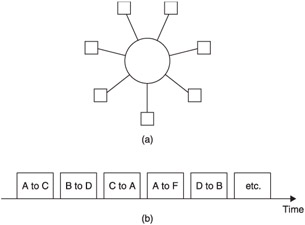1.6 Introduction to Networks
| | ||
| | ||
| | ||
1.6 Introduction to Networks
In the most general sense a network is a means of communication between a large number of places. According to this definition the Post Office is a network, as are parcel and courier companies. This type of network delivers physical objects. If, however, we restrict the delivery to information only the result is a telecommunications network. The telephone system is a good example of a telecommunications network because it displays most of the characteristics of later networks.
It is fundamental in a network that any port can communicate with any other port. Figure 1.10 shows a primitive three-port network. Clearly each port must select one or other of the remaining ports in a trivial switching system. However, if it were attempted to redraw Figure 1.10 with 100 ports, each one would need a 99-way switch and the number of wires needed would be phenomenal. Another approach is needed.

Figure 1.10: A simple three-port network has trivial switching requirements.
Figure 1.11 shows that the common solution is to have an exchange, also known as a router, hub or switch, which is connected to every port by a single cable. In this case when a port wishes to communicate with another, it instructs the switch to make the connection. The complexity of the switch varies with its performance. The minimal case may be to install a single input selector and a single output selector. This allows any port to communicate with any other, but only one at a time. If more simultaneous communications are needed, further switching is needed. The extreme case is where every possible pair of ports can communicate simultaneously .

Figure 1.11: A network implemented with a router or hub.
The amount of switching logic needed to implement the extreme case is phenomenal and in practice it is unlikely to be needed. One fundamental property of networks is that they are seldom implemented with the extreme case supported. There will be an economic decision made balancing the number of simultaneous communications with the equipment cost. Most of the time the user will be unaware that this limit exists, until there is a statistically abnormal condition which causes more than the usual number of nodes to attempt communication.
The phrase 'the switchboard was jammed ' has passed into the language and stayed there despite the fact that manual switchboards are only seen in museums. This is a characteristic of networks. They generally only work up to a certain throughput and then there are problems. This doesn't mean that networks aren't useful, far from it. What it means is that with care, networks can be very useful, but without care they can be a nightmare.
There are two key factors to get right in a network. The first is that it must have enough throughput, bandwidth or connectivity to handle the anticipated usage and the second is that a priority system or algorithm is chosen which has appropriate behaviour during overload. These two characteristics are quite different, but often come as a pair in a network corresponding to a particular standard.
Where each device is individually cabled, the result is a radial network shown in Figure 1.12(a). It is not necessary to have one cable per device and several devices can co-exist on a single cable if some form of multiplexing is used. This might be time-division multiplexing (TDM) or frequency division multiplexing (FDM). In TDM, shown in Figure 1.12(b), the time axis is divided into steps which may or may not be equal in length. In Ethernet, for example, these are called frames . During each time step or frame a pair of nodes have exclusive use of the cable. At the end of the time step another pair of nodes can communicate. Rapidly switching between steps gives the illusion of simultaneous transfer between several pairs of nodes. In FDM, simultaneous transfer is possible because each message occupies a different band of frequencies in the cable. Each node has to 'tune' to the correct signal. In practice it is possible to combine FDM and TDM. Each frequency band can be time multiplexed in some applications.

Figure 1.12: Radial network at (a) has one cable per node. TDM network (b) shares time slots on a single cable.
Data networks originated to serve the requirements of computers and it is a simple fact that most computer processes don't need to be performed in real time or indeed at a particular time at all. Networks tend to reflect that background as many of them, particularly the older ones, are asynchronous.
Asynchronous means that the time taken to deliver a given quantity of data is unknown. A TDM system may chop the data into several different transfers and each transfer may experience delay according to what other transfers the system is engaged in. Ethernet and most storage system buses are asynchronous. For broadcasting purposes an asynchronous delivery system is no use at all, but for copying a video data file between two storage devices an asynchronous system is perfectly adequate.
The opposite extreme is the synchronous system in which the network can guarantee a constant delivery rate and a fixed and minor delay. An AES/EBU router is a synchronous network.
In between asynchronous and synchronous networks reside the isochronous approaches. These can be thought of as sloppy synchronous networks or more rigidly controlled asynchronous networks. Both descriptions are valid. In the isochronous network there will be maximum delivery time which is not normally exceeded. The data transmission rate may vary, but if the rate has been low for any reason, it will accelerate to prevent the maximum delay being reached. Isochronous networks can deliver near-real-time performance. If a data buffer is provided at both ends, synchronous data such as AES/EBU audio can be fed through an isochronous network. The magnitude of the maximum delay determines the size of the buffer and the length of the fixed overall delay through the system. This delay is responsible for the term 'near-real time'. ATM is an isochronous network.
These three different approaches are needed for economic reasons. Asynchronous systems are very efficient because as soon as one transfer completes, another can begin. This can only be achieved by making every device wait with its data in a buffer so that transfer can start immediately. Asynchronous systems also make it possible for low bit rate devices to share a network with high bit rate devices. The low bit rate device will only need a small buffer and will therefore send short data blocks, whereas the high bit rate device will send long blocks. Asynchronous systems have no difficulty in handling blocks of varying size, whereas in a synchronous system this is very difficult.
Isochronous systems try to give the best of both worlds , generally by sacrificing some flexibility in block size. FireWire (see Chapter 5) is an example of a network which is part isochronous and part asynchronous so that the advantages of both are available.
Whilst computer industry network technology is not ideal for real-time audio-visual information, it has to be accepted that the volume of computer equipment production is such that this technology must be less expensive than hardware specifically designed for broadcast use. There will thus be economic pressure to find ways of using it for audio-visual applications.
| | ||
| | ||
| | ||
EAN: 2147483647
Pages: 120